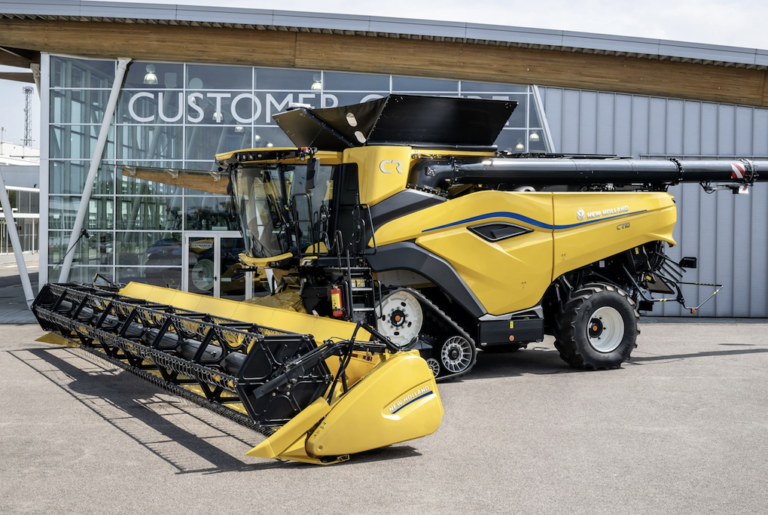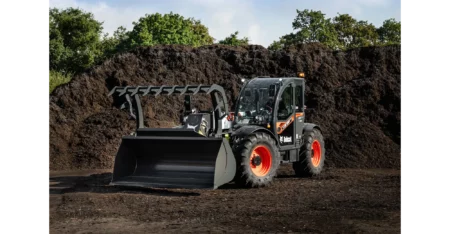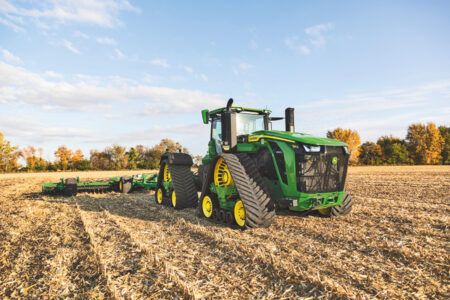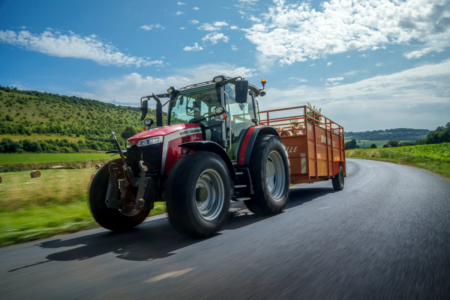The new flagship New Holland CR11 combine previewed at Agritechnica 2023 has been joined by a CR10 companion model at the official harvest 2024 launch of the new Next Generation design, with both harvesters – built at New Holland’s combine Centre of Excellence in Zedelgem, Belgium – featuring innovative new technology designed to help the largest farming enterprises maximise output, minimise losses and reduce total cost of harvesting.
The primary difference between the two models is in power and grain tank size, to ensure the new combines match the needs of a broad range of large farm enterprises. The CR11 features a 20,000-litre grain tank and a 15.9-litre FPT Cursor 16 engine producing 775hp. The CR10 engine is a 12.9-litre FPT Cursor 13 generating 635hp, while its grain tank holds 16,000 litres. Beyond additional power and grain capacity, the key features that take these combines into a new league in terms of output, sample quality and loss minimisation include longer twin rotors and the new Twin-Clean cleaning system.
More capacity from front to rear
From the front, these new flagship CR combines are designed to handle greater volumes of crop. Cutterbar widths of 10.6-15.0m (35-50ft) are available in fixed, flexible knife, movable knife and draper formats. Corn/maize heads of 12-16 rows are also available, and unloading auger lengths can be specified to match all header widths. There are three driveline options to meet all header requirements – standard with fixed drive, standard with variable drive, and a variable heavy-duty system. On the variable driveline, a CVT drive unit on the engine gearbox allows header/feeder speed to be varied depending on crop and field conditions. Feeder/header reversing is achieved via with a hydraulic motor on the fixed speed driveline, and with the CVT drive on the variable speed driveline.
The elevator is equipped as standard with front face adjustment and lateral tilt remote controlled from the cab. From here the crop is fed to New Holland’s proven Dynamic Feed Roll system, which can now be reversed – simultaneously with the elevator and the rotors – in the event of a blockage. The DFR accelerates the crop and splits it into two even streams to feed the two longitudinal threshing and separating rotors that follow. A large stone trap in front of the DFR can be emptied either manually or, optionally, remotely via hydraulic activation from the cab.
New Holland was the first to launch a combine featuring two longitudinal rotors at its heart, pioneering its Twin Rotor threshing and separation technology almost 50 years ago, in 1975. Over time, its design has evolved to ensure it meets similarly evolving demands for throughput, grain protection, grain retention and straw quality. In the new CR10 and CR11, the two 600mm (24in) rotors are of increased diameter and length, providing greater capacity for the crop to circulate and the grain be be threshed and separated. Each rotor features 40 standard rasp bars, eight HX raspbars and 12 spiked raspbars.
The HX units combine the height of spiked raspbars with the profile of the standard units, with a greater sidewall angle helping accelerate crop flow in the transition zone of the stepped rotor cage, between the threshing zone and the separation zone. Vane angle can be remotely controlled from the cab, and the new vane design aids crop ejection should the rotors need to be reversed. New rotor cages feature a stepped design with a broader cage and higher vanes in the separation area, to allow greater crop mat movement, improved separation and enhanced power efficiency. The concave area comprises two sets of three lightweight threshing concaves and separation grates, and two sets of six lightweight grates.
All-new TwinClean cleaning shoe
The new TwinClean cleaning shoe incorporates multiple features to boost throughput and minimize grain loss. It consists of two sieve systems in sequence, each having its own upper and lower sieve and clean grain auger, and is based around a large grainpan with an increased fallstep to the first upper sieve. Airflow is provided by a high-power cleaning shoe fan. Two automatic cross distribution mechanisms, one on the grainpan and one on the upper sieves, guarantee an even cleaning shoe load in all conditions.
Two sets of pressure sensors, one on the grainpan and one on the upper sieves, continuously measure the cleaning shoe load and detect any anomalies in material distribution between left and right. A side-shake mechanism adds a lateral component to the grainpan and sieve movement which evens out the material over the cleaning shoe’s full width. As such, the cleaning shoe can compensate for uneven feeding and side slopes up to 28%. Overall size of the complete sieve area is 8.76 m².





